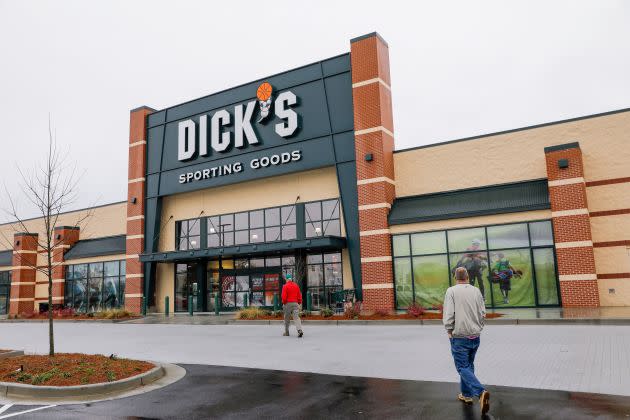Dick’s Outperforms Competitors, Plans to Expand House of Sport to Fuel Growth

Dick’s Sporting Goods seems to be avoiding the demons that have haunted its competitors, and it has plans to continue to grow, mainly by expanding its House of Sport concept, revamping its Dick’s stores, and growing the Moosejaw brand it acquired earlier this year.
House of Sport is a concept the retailer has described as “a place to connect and play,” with climbing walls, batting cages, golf simulators and other services.
More from WWD
Lauren Hobart, president and chief executive officer, said House of Sport “will be a significant part of our growth story and the primary driver of our square footage growth. House of Sport is fostering very strong engagement with both our athletes and our brand partners, all while delivering much higher sales and profits.”
She said the company will open nine of these stores to the existing three before the back-to-school season and at least another 10 next year. By the end of 2027, she expects Dick’s to have between 75 and 100 House of Sport locations across the country.
Another growth strategy revolves around what Hobart defined as the “next generation Dick’s store,” which will take some of the key components of House of Sport — including “premium experiences, an elevated service model and enhanced visual expression” — and incorporate them into the more traditional Dick’s stores that average 50,000 square feet. House of Sport stores are about double that size.
She said the company will also continue to invest in technology to enhance its digital experience. Recent updates include access to rewards, upcoming launches and in-app reservation capabilities for hot sneaker releases.
The company’s recent acquisition of Moosejaw from Walmart is expected to make a contribution to Dick’s bottom line this year, adding about $100 million in net sales in 2023.
GameChanger, a scoring and statistics mobile app for youth sports that Dick’s acquired in 2016, continued to post “robust revenue growth and massive engagement increases” in the period, Hobart said, with nearly 2 million games played on the platform, up 25 percent over last year. “We’ll continue innovating and investing in our GameChanger business as we strengthen our relationships with our athletes on and off the field.”
The CEO revealed these moves as Dick’s reported gains in both earnings and sales, bucking the trend seen at its competitors. Last week, Foot Locker missed projections, sending the stock of the athletic retailer spiraling down along with one of its largest brands, Nike, which has analysts questioning its focus on direct-to-consumer sales rather than wholesale.
But Dick’s, which is celebrating its 75th anniversary this year, reported a 17 percent increase in net income for the period ended April 29 to $305 million from $261 million the prior year on a 5.3 percent gain in sales to $2.8 billion from $2.7 billion. Comparable-store sales also rose 3.4 percent in the period, driven by a 2.7 percent increase in transaction as well as higher average ticket prices, the company said.
As a result of the strong showing, the Pittsburgh, Pennsylvania-based retailer reaffirmed its 2023 outlook of full-year earnings per diluted share of $12.90 to $13.80 with comparable-store sales projected to be flat to up 2 percent.
In an earnings call after the results were revealed, Hobart said the sporting goods retailer managed to beat expectations despite the “macroeconomic uncertainties” that its customers face. “In fact, compared to the same period of last year, more athletes purchased from us, they purchased more frequently and they spend more each trip,” she said, adding, “As the largest U.S. sporting goods retailer, we have robust runway for growth and are well positioned to continue gaining share in a fragmented $140 billion industry.”
Hobart said footwear continues to be “a key pillar” for the company. In the quarter, the company added premium full-service footwear shops to 20 stores and by the end of the year, this concept will be included in more than 75 percent of Dick’s fleet of more than 850 stores. The footwear shops allow the company to offer an expanded assortment of existing and emerging brands.
In apparel, Hobart said Dick’s will continue to invest in its vertical brands including Burst and Calia golf apparel and fitness accessories.
Neil Saunders, managing director of GlobalData, cited Dick’s “improved offer,” particularly in the casualwear end of the market, as one of the key reasons it has managed to outperform the other sporting goods players.
“From our data, it is clear that Dick’s has picked up more customers who are shopping for everyday clothing and this has largely come at the expense of department stores and the middle market,” he wrote in a research note Tuesday. “The shift is helped by continued trends of casualization, including in workwear as people continue to work remotely or dress more casually at the office. Dick’s has aligned itself with these trends by expanding its assortment and becoming much more of a destination for general apparel purchase.”
On the sporting goods side, he added, while demand has moderated a bit “there is still elevated consumer interest in fitness which is helping Dick’s. Moreover, the company is outperforming in categories like footwear thanks to strong offers, which include a nicely balanced range of products, including newer and innovative brands. In our view, this sets Dick’s apart from rivals like Foot Locker and makes it one of the key destinations for those seeking sneakers for a wide range of activities.”
Although the numbers are strong now, Saunders cautioned that the company’s growth may moderate the remainder of the year as consumer demand softens and “top-line growth is likely to flatten off.” The stock closed down 1.4 percent to $124.58 on Tuesday.
Best of WWD

